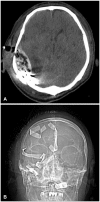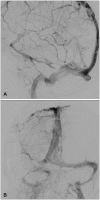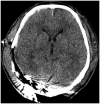Endovascular Treatment Following Gauze Packing for the Control of Massive Bleeding from Traumatic Transverse Sinus Lesion
- PMID: 30402436
- PMCID: PMC6218356
- DOI: 10.13004/kjnt.2018.14.2.150
Endovascular Treatment Following Gauze Packing for the Control of Massive Bleeding from Traumatic Transverse Sinus Lesion
Abstract
Posterior fossa epidural hematoma (EDH) is uncommon, but the related clinical deterioration can occur suddenly. Accompanying venous sinus injury and lacerations are associated with 40% to 80% mortality. The authors present one clinical case of a patient with posterior fossa EDH from transverse sinus bleeding. A 57-year-old male was injured after falling while working. He was taken to the hospital, where computed tomography scans of his brain revealed a right posterior temporal and cerebellar EDH with a right temporo-occipital fracture. He underwent a right parieto-occipital craniotomy, incorporating the fracture line. Longitudinal laceration of the right transverse sinus extending to the sigmoid sinus with profuse bleeding was identified. Four gauzes were inserted in the epidural space for tamponade of the injured sinus. Conventional angiography and coil embolization for the injured sinus were immediately performed. Subsequently, the patient was transferred to the operating room, wherein staff members removed the gauzes and remnant hematoma. Based on this experience, the authors recommend that for posterior fossa EDH from transverse sinus bleeding, bleeding control should be performed by gauze packing and endovascular treatment.
Keywords: Intracranial epidural hematoma; Posterior cranial fossa; Therapeutic embolization.
Conflict of interest statement
The authors have no financial conflicts of interest.
Figures




Similar articles
-
Gauze Packing for the Massive Venous Sinus Bleeding in a Patient with Acute Subdural Hematoma of Posterior Fossa.Korean J Neurotrauma. 2019 Oct 15;15(2):164-169. doi: 10.13004/kjnt.2019.15.e30. eCollection 2019 Oct. Korean J Neurotrauma. 2019. PMID: 31720271 Free PMC article.
-
Delayed post-traumatic large subgaleal hematoma caused by diastasis of rhomboid skull suture on the transverse sinus.Childs Nerv Syst. 2015 Apr;31(4):621-4. doi: 10.1007/s00381-014-2531-3. Epub 2014 Aug 21. Childs Nerv Syst. 2015. PMID: 25142690
-
Acute posterior fossa epidural hematoma in a newborn infant with Menkes disease.Pediatr Emerg Care. 2014 Feb;30(2):117-9. doi: 10.1097/PEC.0000000000000078. Pediatr Emerg Care. 2014. PMID: 24488163
-
Surgical management of traumatic supra and infratentorial extradural hematomas: our experience and systematic literature review.Neurosurg Rev. 2020 Jun;43(3):893-901. doi: 10.1007/s10143-019-01083-7. Epub 2019 Feb 4. Neurosurg Rev. 2020. PMID: 30715641
-
Development of a delayed acute epidural hematoma following contralateral epidural hematoma evacuation: case report and review of literature.Acta Neurol Belg. 2019 Mar;119(1):15-20. doi: 10.1007/s13760-018-1049-y. Epub 2018 Nov 26. Acta Neurol Belg. 2019. PMID: 30478538 Review.
Cited by
-
Gauze Packing for the Massive Venous Sinus Bleeding in a Patient with Acute Subdural Hematoma of Posterior Fossa.Korean J Neurotrauma. 2019 Oct 15;15(2):164-169. doi: 10.13004/kjnt.2019.15.e30. eCollection 2019 Oct. Korean J Neurotrauma. 2019. PMID: 31720271 Free PMC article.
-
A case report of using gauze packing to treat postoperative chest bleeding after left pneumonectomy for secondary rifampicin-resistant tuberculosis.IDCases. 2024 Apr 22;36:e01953. doi: 10.1016/j.idcr.2024.e01953. eCollection 2024. IDCases. 2024. PMID: 38707650 Free PMC article.
References
-
- Bor-Seng-Shu E, Aguiar PH, de Almeida Leme RJ, Mandel M, Andrade AF, Marino R., Jr Epidural hematomas of the posterior cranial fossa. Neurosurg Focus. 2004;16:ECP1 - PubMed
-
- Bozbuğa M, Izgi N, Polat G, Gürel I. Posterior fossa epidural hematomas: observations on a series of 73 cases. Neurosurg Rev. 1999;22:34–40. - PubMed
-
- Braff SB, Khoshyomn S, D'Angelo WF, Tranmer BI, Wilson JT. Traumatic transverse sinus laceration. Pediatr Neurosurg. 2004;40:143–144. - PubMed
-
- Chee CP, Habib ZA. Hypodense bubbles in acute extradural haematomas following venous sinus tear. A CT scan appearance. Neuroradiology. 1991;33:152–154. - PubMed
Publication types
LinkOut - more resources
Full Text Sources

